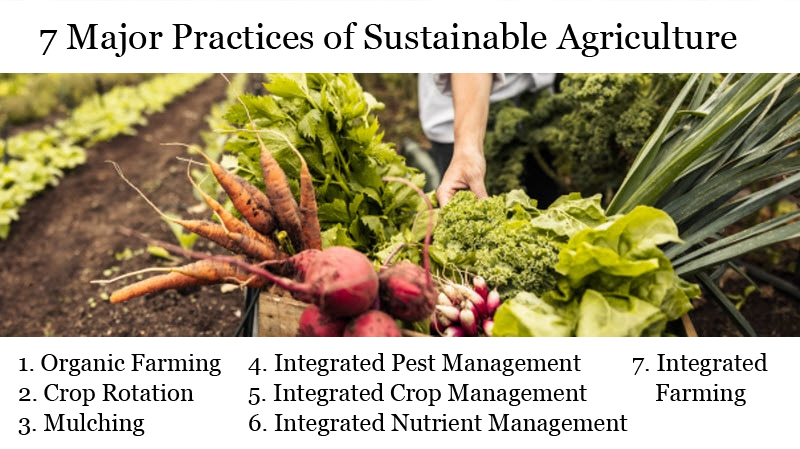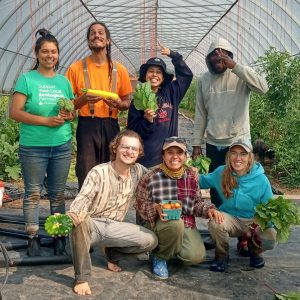What is Sustainable Agriculture?
The term "sustainable agriculture" was defined in 1977 by the USDA as an integrated system of plant and animal production practices having a site-specific application that will, over the long term.
- satisfy human food and fiber needs
- enhance environmental quality and the natural resource base upon which the agriculture economy depends
- make the most efficient use of nonrenewable resources and on-farm resources and integrate, where appropriate, natural biological cycles and controls
- sustain the economic viability of farm operations
- enhance the quality of life for farmers and society as a whole.
Yet the idea of having a sustainable relationship with the land has been prevalent in indigenous communities for centuries before the term was formally added to the lexicon.

By today’s definition, sustainable agriculture is defined as farming in ways that meet society's present food needs, without compromising the ability for current or future generations to meet their needs. It is based on an understanding of the interaction of global ecosystems. There are many methods to increase the sustainability of agriculture. When developing agriculture within sustainable food systems, it is important to develop flexible business processes and farming practices allowing everything to work together. This is not an easy task, especially when business and commerce are involved.
Sustainable agriculture is a set of principles and practices that aim to eliminate avoidable harm to people, animals, and the environment from commercial food production. Rather than extracting value from natural systems, sustainable agriculture preserves and strengthens ecosystem function both on and off the farm. These ideas and techniques align with many of the United Nations’ Sustainable Development Goals.
Sustainable agriculture can provide pathways to increased economic stability, create opportunities for farmers and farming communities, improve the living conditions of farmed animals and wild animals, and lead to better environmental stewardship—all of which will help to build a healthier world.
What are the practices of Sustainable Agriculture?
- Practicing agriculture sustainability is about farming in harmony with the natural landscape.
- Prioritizing the long-term health of the full ecosystem.
- Reducing or eliminating synthetic inputs which include avoiding the use of pesticides and herbicides, using heirloom or saved seeds rather than improved hybrid seeds, rotating crops to reduce pest populations, and, where feasible and appropriate, using manual rather than mechanized harvest methods to reduce the use of fossil fuels.
- Protecting and regenerating soil by means of planting cover crops to avoid exposing bare soil to the elements, increasing organic matter through the use of compost and green manure crops, and reducing or avoiding tillage of the soil.
- Encouraging beneficial biodiversity which includes avoiding toxic inputs, growing diverse crops, planting non-crop vegetation to attract pollinators and promote pest predators, and integrating forestry into farming where possible.
What are the Challenges of Biodiversity?
The biggest challenges crop farmers face is crop damage by disease and pests which has led to the widespread use of chemical fertilizers, herbicides and pesticides. Healthy soils and proper nutrient management help plants stay robust to disease. When diseases do occur, crop diversity and natural remedies can reduce impacts to crops without harmful chemicals. With the right knowledge, diseases and pests can be kept under control by harnessing natural processes, removing the need for synthetic pesticides, herbicides, and fungicides that harm ecosystem health. With an understanding of the life cycle of pests, their natural predators, and their habitats, infestations can be prevented or controlled.
Ensuring soil fertility is another pressure that causes many farmers to turn to synthetic fertilizers. By building soil fertility naturally farmers are able to safeguard soil health which is key for ensuring long-term productivity in farming regions. Reducing soil disturbances like tillage and the use of heavy machinery helps soil remain uncompacted and will prevent fertile topsoil from being lost to erosion. Planting cover crops between more profitable harvests boost soil nutrients and helps soils hold more moisture. Diversifying and rotating crops, rather than planting a single crop species in the same field year after year, protects soils from becoming depleted and supports robust populations of microorganisms that deliver nutrients to crops.
Why is Sustainable Agriculture Important?
“Sustainability” encompasses a variety of metrics, and sustainable farming can have a positive effect on a range of issues, from conserving natural resources to improving the health of individuals and communities.
Why is Sustainable Agriculture Important to the Environment?
We live on a planet with finite resources, so it is imperative to use these resources wisely. Sustainable agriculture helps to conserve natural resources and ensure their viability for future generations. Sustainable agricultural practices can safeguard and build fertile soil, which is essential for the optimal growth of food crops. Sustainable agriculture makes wise use of freshwater resources and ensures that runoff remains free of toxic pollutants while moving downstream to other ecosystems or human consumers. Sustainable agriculture also reduces reliance on synthetic fertilizers and pesticides and encourages a diversity of plant life through crop rotation and planting various species of beneficial non-crop vegetation on the borders of fields. All these features help to sustain healthy, biodiverse environments on and around farms.
Resources:
Wikipedia
Stray Dog Institute



